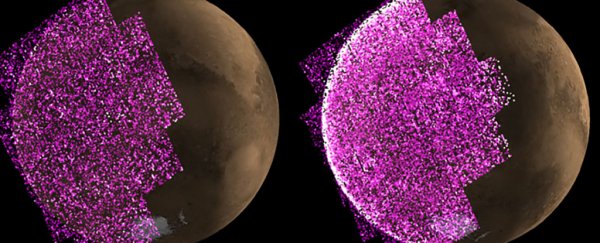Turn your attention to the stars and you don't have to wait long to see something literally out of this world – like the global ultraviolet aurora that just occurred on Mars, which was 25 times brighter than anything we've observed on the Red Planet before.
Triggered by a strong blast of solar wind from the Sun, the event also sent the planet's radiation levels soaring, to more than twice the maximum level previously recorded by the Curiosity Rover's Radiation Assessment Detector (RAD).
These spectacular aurora light shows we can observe on Earth, Mars, and other planets are caused as high energy particles spewing out of the Sun hit planetary magnetic fields, causing chemical reactions with gases in the atmosphere.
According to Sonal Jain, from the University of Colorado and part of NASA's Mars Atmosphere and Volatile Evolution team (MAVEN), this particular blast of energy from our star "lit up Mars like a lightbulb" with ultraviolet light.
"An aurora on Mars can envelope the entire planet because Mars has no strong magnetic field like Earth's to concentrate the aurora near polar regions," says Jain.
"The energetic particles from the Sun also can be absorbed by the upper atmosphere, increasing its temperature and causing it to swell up."
 The purple/white shows UV intensity over Mars. Credit: NASA/Univ. of Colorado
The purple/white shows UV intensity over Mars. Credit: NASA/Univ. of Colorado
The MAVEN orbiter has been tracking the interaction of solar wind with the Martian atmosphere since 2014, and together with data collected from Curiosity stretching back to 2011, we're getting some vital information about conditions on Mars.
If we're eventually going to live on the planet, we'll need to know when and how to take cover when this dramatic events occur. They'll be great to look at, but not so great to be outdoors in, as the radiation readings show.
"If you were outdoors on a Mars walk and learned that an event like this was imminent, you would definitely want to take shelter, just as you would if you were on a space walk outside the International Space Station," says one of the RAD team, Don Hassler from the Southwest Research Institute.
"To protect our astronauts on Mars in the future, we need to continue to provide this type of space weather monitoring there."
Though we're better protected by the Earth's magnetic field, scientists are still worried that a freakishly big solar storm could knock out most of our planet's communications equipment. To be prepared, we need to learn as much as possible about these space weather events.
In fact, scientists think that solar winds are responsible for stripping the Earth-like atmosphere off of Mars billions of years ago – another discovery made possible with data collected from MAVEN.
Oddly enough, this off-the-charts solar event has come during what's usually a quiet period in the Sun's 11-year cycle of sunspots and storm activity.
NASA scientists are now digging deeper into the data to find out what we can learn from it, but it's likely to teach us a lot about how we can deal with these events in the future, as well as the composition of the Martian atmosphere itself.
"It will improve our understanding of how such solar events affect the Martian environment, from the top of the atmosphere all the way down to the surface," says Hassler.
